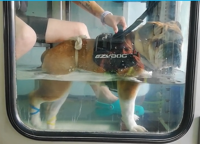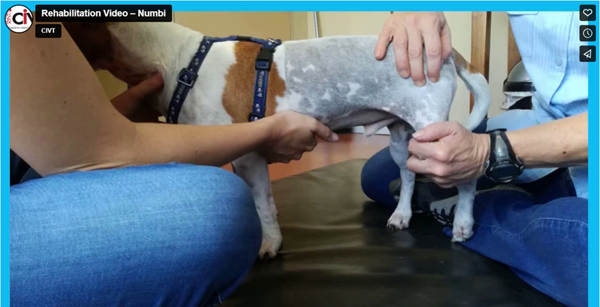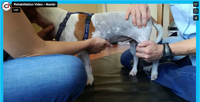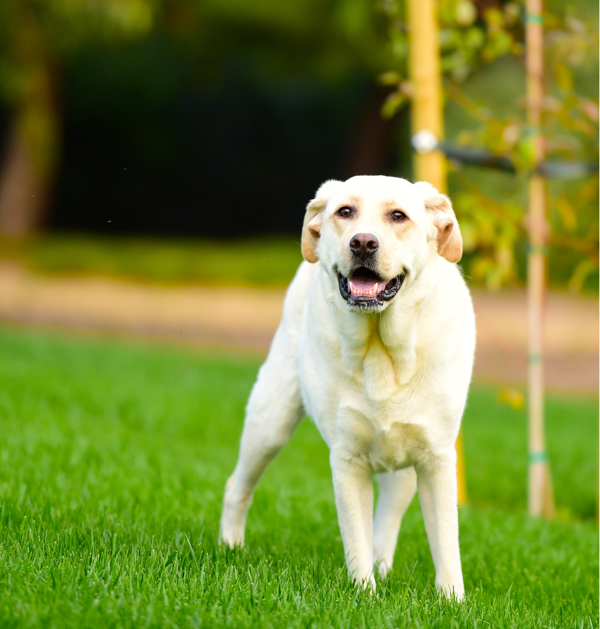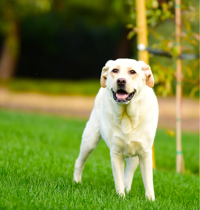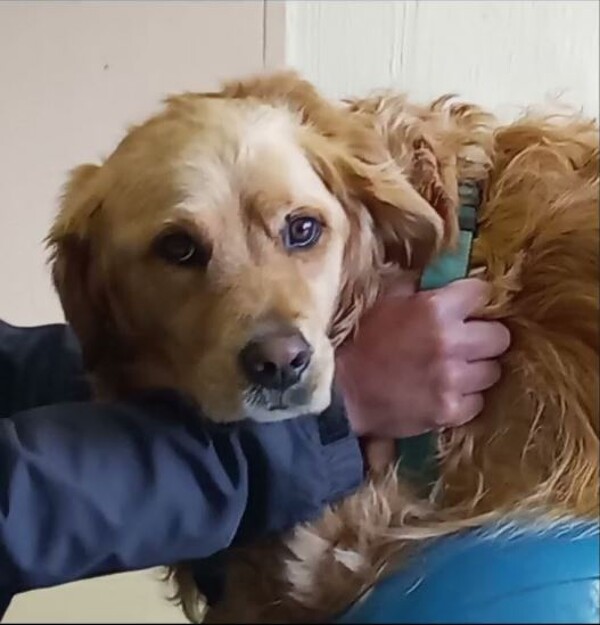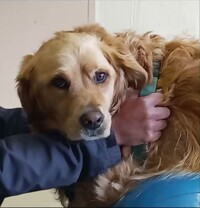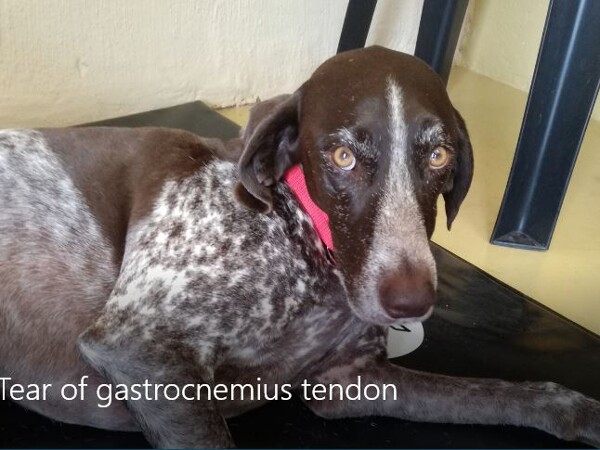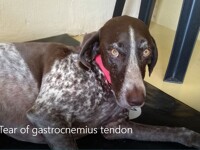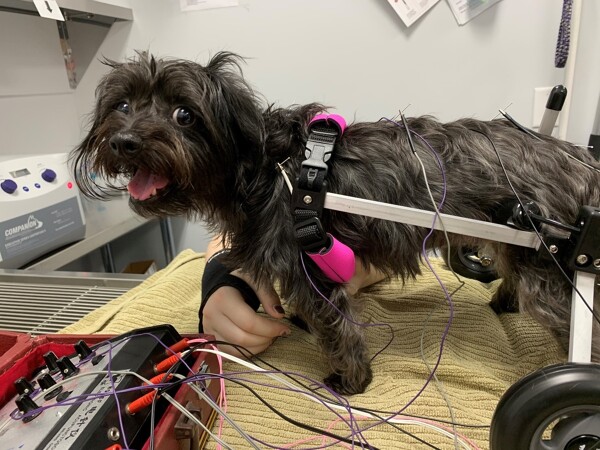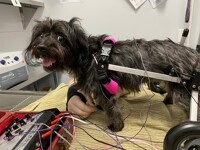Click the image to view the original image
Feline Cervical Myelopathy Successfully Treated with Physical Rehabilitation
Aslan, domestic cat, neutered male, five years old
DATE OF INITIAL PRESENTATION
September 1st, 2024
HISTORY
Before his initial presentation Aslan had no known medical issues.
His symptoms first appeared on August 28, 2024. While observing a stray cat outside the window, Aslan reacted to another house cat approaching him. He reportedly fell off the stool he was standing on. Shortly afterward, his owner noticed difficulty in his movements: he was dragging himself on the floor, unable to stand, with his left side more affected. Following this episode, the owners sought veterinary advice to investigate the issue.
Upon arrival, Aslan was non-ambulatory and unable to support the weight of his head for long. He exhibited paralysis in his left thoracic limb, while the other limbs still showed some voluntary movements. There was an absence of proprioceptive reflex in the left limbs, a severe delay in the right thoracic limb, and a moderate delay in the left thoracic limb. An MRI was conducted to confirm the diagnosis, but the complete final report has not yet been received.
At his first appointment at Aniforme Rehab Centre on September 1st, Aslan was non-ambulatory, but he appears to have slightly more tone in his neck. He attempts to drag himself using his right thoracic limb, though it is challenging. During the appointment, he was able to hold himself up slightly with the help of his front right limb. Aslan does not seem to have normal stools, he is experiencing occasional episodes of diarrhea, and his urine has a strong odor.
*In Quebec, veterinary technicians perform treatments and assess animals during the first visit and follow-up appointments at rehabilitation centers. This is why an initial examination by a veterinarian at a clinic, hospital, or emergency center is required before the cat is seen for therapy. Veterinary technicians can implement treatment plans based on the diagnosis, which is pre-approved and later reviewed by the vet or medical director of the rehabilitation center. As I am a veterinary technician, I cannot make diagnoses. If there are any changes in Aslan’s condition, I would have to refer him to his veterinarian.
DIAGNOSIS
Intramedullary lesion suggesting fibrocartilaginous embolic myelopathy (FCEM) affecting both sides of the cervical spinal cord, but more severely on the left side, between C5 and C7.
EVALUATION - NEUROLOGIST EXAMINATION
Date of Presentation:
Thursday, August 29, 2024
Reason for Presentation:
Aslan was presented to the neurology service for the investigation of changes in his gait (non-ambulatory).
Diagnostic Procedures:
Neurological Examination
- Mental State:
- Appears sedated and very calm, likely secondary to gabapentin administration the night before (11 PM, examined at 10 AM).
- Good temperament and gentle but growls at certain manipulations and licks the blanket in frustration.
Gait and Posture:
- Non-ambulatory in all four limbs, unable to support the weight of his head for long periods but can turn it from side to side unassisted.
- Voluntary movements observed in the hind limbs and the right thoracic limb. The left hind limb is weaker than the right, and the best-performing limb is the right hind limb.
- Paralysis in the left thoracic limb, with no observed
- Preserved tone in the hind limbs, reduced tone in the right thoracic limb, and absent tone in the left thoracic limb.
Cranial Nerves:
- Partial Horner’s syndrome on the left side (smaller left pupil, mild enophthalmos on the left).
- No other anomalies.
Postural Reactions:
- Absence of proprioceptive placement or hopping responses in the left limbs.
- Severe delay in proprioceptive placement and hopping in the right thoracic limb and moderate delay in the right hind limb.
Spinal Reflexes:
- Withdrawal reflex absent in the left thoracic limb and reduced in the right thoracic limb.
- Withdrawal reflex present, easy to induce, and strong in the hind limbs.
- Patellar reflex present, easy to induce, and strong bilaterally.
- Trunk cutaneous reflex not observed.
Nociception:
- Perineal reflex present and adequate bilaterally.
Pain Assessment (Back/Neck):
- No induced pain upon palpation along the spine.
- Full range of motion in the cervical spine without reaction to manipulation or pressure on cervical vertebrae.
Analysis:
Cervical myelopathy at C6-T2, acute onset, asymmetrical, non-painful, more severe on the left side. The changes in mental state are suspected to be secondary to recent gabapentin administration but should be reassessed after discontinuing the medication. Owners reported that Aslan appeared more alert and interactive at home.
Potential Causes:
- Vascular: Fibrocartilaginous embolic myelopathy (FCEM).
- Inflammatory: Infectious or non-infectious myelitis.
- Tumoral: Lymphoma.
Discussion and Recommended Tests:
- Given the acute, asymmetrical, and non-painful presentation, fibrocartilaginous embolic myelopathy is the most likely diagnosis.
- Discussed the potential causes and prognosis with the owners. FCEM generally has an excellent prognosis; however, involvement of the brachial plexus reduces prognosis due to damage to the gray matter. The severely affected left thoracic limb may not recover. The current condition may represent the peak of the disease, and improvement might follow. Proper diagnosis increases the chances of recovery.
Plan A:
MRI is recommended for optimal visualization of the lesion and to address the primary issue. If inflammation is detected, cerebrospinal fluid (CSF) analysis may clarify the diagnosis, aid treatment, and refine the prognosis. Estimated costs range from CAD $3,300 (MRI) to CAD $4,200 (MRI + CSF analysis).
Plan B:
Symptomatic management for the most probable cause. Without a clear diagnosis, treatment adaptation and precise prognosis remain challenging.
The owner chose Plan A, with an MRI scheduled. Adjustments to the plan will be made based on the results.
MRI Findings:
- Preliminary Impression (verbal): Intramedullary lesion suggesting fibrocartilaginous embolic myelopathy (FCEM) affecting both sides of the cervical spinal cord, more severe on the left side, between C5 and C7.
FUNCTIONAL ASSESSMENT
DATE OF PRESENTATION: September 1st, 2024
LOCATION: Aniforme Rehab Center
MEDICATIONS/SUPPLEMENTS:
Dexamethasone.
MUSCLE CIRCUMFERENCE (cm):
Not rated, Aslan is unble to stand on his own.
MUSCLE CONDITION:
Presence of muscle mass loss in all four limbs.
RANGE OF MOTION:
All ranges of motion appear normal.
PALPATION:
Aslan doesn't seem to show any tension, but when we try to pick him up or lift him, he starts to growl a bit and hiss.
REFLEX:
RFL: The withdrawal reflex seems good, and his proprioception appears normal. He tries to stand up with this paw.
LFL: No withdrawal reflex, no deep pain, no proprioception.
RHL: The withdrawal reflex seems good, he kicks, and his proprioception appears normal. LHL: The withdrawal reflex seems good, he kicks, but proprioception is not yet present.
GAIT:
Non-Ambulatory, he is not even able to drag himself on the ground.
STANDING POSITION:
When placed in a standing position, Aslan isn’t able to support himself. Aslan is an obese cat, which doesn’t help.
SITTING AND LYING POSITION:
Aslan is lying on one side and the owners change him from one side to the other, maximum every four hours.
MASTER PROBLEM LIST:
- Non-ambulatory
- Loss of muscle mass
- Urinary and fecal incontinence
- Obesity
GOALS OF THERAPY:
- Regain bladder and bowel control.
- Restore reflexes and eventually return to walking.
- Increase muscle mass.
- Achieve weight loss.
TREATMENT PLAN:
In-Center Treatment:
Underwater treadmill sessions were recommended combined with an exercise plan at home.
- Frequency: Ideally 2-3 times a week, but clients can only come once a week for 4 to 6 weeks (for underwater treadmill), followed by a reevaluation.
At-Home Exercise Plan:
- Passive Range of Motion (PROM) on all four limbs:
- Repetitions: 10 times per side.
- Weight shifting on the ground:
- Repetitions: 7 times per side.
- Withdrawal exercise:
- Repetitions: 7 times for each.
- Proprioceptive placement:
- Repetitions: As often as possible.
- PROM by rubbing the toes on a textured surface:
- Repetitions: 7 times for each paw.
- Back massage:
THERAPIES:
In-Center Treatment:
Underwater Treadmill, assist movement in the water.
At-Home Exercise Plan:
Use the thoracic and pelvic harness to help you support Aslan during his program.
EXERCISES:
➔ Back massage:
Helps reduce muscle tension and help with comfort. Aslan does not have any discomfort for now, but as soon as he is going to move more on his own, he might compensate and create some tension. The massage was given to help prevent these tensions.
➔ PROM by rubbing the toes on a textured surface:
Stimulate the neurological system while maintaining Aslan’s range of motion.
➔ Withdrawal exercise:
Stimulates the neurological system and helps prevent regression.
➔ Weight transfer on the ground:
Aims to preserve muscle mass and leg sensation (can be done on a textured surface).
➔ Passive range of motion:
Preserves Aslan’s range of motion.
➔ Proprioceptive placement:
Ensures proper positioning of his paws.
___________________________________________________________________________________________________________________________
FOLLOW-UP APPOINTMENTS
DATE OF PRESENTATION: September 8th, 2024
LOCATION: Aniforme Rehab Center
#1- This appointment was Aslan’s second visit at Aniforme Center
Aslan seems to have more muscle tone. He is starting to show a slight withdrawal reflex on the left front limb with some voluntary movements. When placed in the right position, he is able to put weight on his left front limb. The exercises are going well, but Aslan is starting to get impatient while doing them.
In-Center Treatment:
Underwater treadmill, 4 minutes total at 0.6 MPH. 2 minutes walking, 2 minutes break with weight shifts in the water, then another 2 minutes.
*Aslan is walking alone, but I'm helping with the positioning of his front left paw in the treadmill so that he puts it with the right proprioception.
Recommendations following this appointment (as also given at his first visit):
Exercise Time
- Divide exercise sessions into several small blocks throughout the day if your cat has low tolerance. Cats are sprinters, not marathoners! Favor sessions of 5 to 10 minutes, but multiple times a day to prevent loss of interest or choose times when you'll have an easier time getting their attention, like before meals.
Environment Adjustment
- Adapt the home according to their For example: Allow them to be on the windowsill, but on the floor.
Tools
- Using non-slip mats can help provide better support and stability for moving confidently and without You can place them in areas where your pet spends the most time or in the most used corridors of the house. Non-slip adhesive pads can also be used.
- To work on stability, animal fitness equipment pieces can be recommended to increase your pet's grip on an unstable surface and focus on trunk muscles and You can do most of the exercises below with this type of equipment.
- Pelvic harnesses are very useful for supporting your cat’s weight ergonomically while allowing free movement of the limbs during Get guidance on-site to adjust and choose the right harness.
Incontinence
- For cats with urinary incontinence, bladder emptying should be done 3 to 4 times a day to prevent urinary infections. Find the bladder and apply firm—but gentle—pressure consistently until the urine stream ends and the bladder feels flat. If you have more difficulty, practice in the morning when the bladder is full, or a few hours after providing a good bowl of water.
- Natural supplements for the bladder can be added to help maintain a healthy urinary tract flora and reduce the chances of urinary Wearing diapers can greatly help keep the environment clean, but they should be changed regularly.
- For fecal incontinence, probiotics like Progut or pumpkin powder or puree can help improve the texture and quality of stools, reducing the mess.
Natural Supplements
- We suggest Omega-3 supplements to help reduce inflammation and improve The therapeutic dose is 100-200 mg/kg EPA and DHA.
- Flexadin Advanced for cats is an excellent collagen-based supplement to support joint
Other Beneficial Treatments
- Acupuncture and/or osteopathy treatments would be beneficial for comfort and proper recovery. It is recommended to wait 48 hours between alternative medicine treatments and physical rehabilitation.
Aslan has gained some movement. Aslan is able to stay slightly elevated on his own. He is no longer lying on his side constantly like at the last appointment.
Continue the home exercise plan and the underwater treadmill sessions.
DATE OF PRESENTATION: September 15th, 2024
LOCATION: Aniforme Rehab Center
#2- This appointment was Aslan’s third visit to Aniforme Center - 15/09/2024
Aslan is doing well, still incontinent. However, he is able to stand on his own and take 3-4 steps. He eats while standing on a box to support his abdomen.
Underwater Treadmill: 8 minutes total at 0.6 MPH. 4 minutes, 2 minute break with weight shifts in the water, then another 4 minutes.
*I’m helping with the positioning of his front left paw in the treadmill so that he puts it with the right proprioception.
At-Home Exercise Plan:
Aslan is now able to move a little bit more in the house. He is taking a few steps without any support.
Continue working with the exercises at home, Aslan is improving quickly!
DATE OF PRESENTATION: September 23rd, 2024
LOCATION: Aniforme Rehab Center
#3- This appointment was Aslan’s fourth visit to Aniforme Center - 23/09/2024
Aslan is doing well and continues to improve. This week, he attempted to get to his litter box on his own. It still seems difficult for him to enter by himself, but he appears to have better control over his bladder. He was able to take 8-10 steps on his own without assistance.
Underwater Treadmill:
8 minutes at 0.8MPH, walking alone and helping him with his left front paw placement in the water. Weight shifting while the water is drained. In the treadmill, Aslan seemed to have difficulty with his proprioception with his front left paw, but at home he is placing that paw well on the ground.
At-Home Exercise Plan:
Continue the home exercise plan and the underwater treadmill sessions.
DATE OF PRESENTATION: September 29th, 2024
LOCATION: Aniforme Rehab Center
#4- This appointment was Aslan’s fifth visit to Aniforme Center - 29/09/2024
Aslan is doing well and continues to progress. This week, he tried to climb onto a chair. He is moving more and more around the house. His LFL still shows some stumbling steps, and his LHL still slips on the floors, but less so. The exercises are still going well and Aslan is starting to regain his pre-condition behavior.
Underwater Treadmill:
12 minutes at 0.8MPH, walking alone and helping him with his left front paw placement in the water. Weight shifting while the water is drained.
He is still not positioning his left front limb with the right proprioception in the underwater treadmill all the time, but a few good steps here and there were seen today. We can see that Aslan wants to work to get his full mobility.
At-Home Exercise Plan:
Continue the home exercise plan and the underwater treadmill sessions.
DATE OF PRESENTATION: October 13th, 2024
LOCATION: Aniforme Rehab Center
#5- This appointment was Aslan’s sixth visit to Aniforme Center - 13/10/2024
Aslan is doing well; he is able to move around the house on his own. He can go up and down the stairs slowly, but his left pelvic limb drags slightly behind.
Underwater Treadmill:
15 minutes at 0.6mph with good support of water. See videos: Aslan Rehabilitation Video
In the underwater treadmill, Aslan presented good proprioception in his left thoracic limb
without any help! He still places a bit on the tips of his toes, but there is no noticeable lameness. We can also see in the video that his left hind limb is sliding back when he tries to put weight on it, like the owner saw at home.
Exercises:
New exercises given since Aslan is able to move around the house on his own. Cavaletti 3-5cm high. 3 repetitions of 2-3 cavaletti rails. Place 2 objects approximately 1.5 meters from each other and make Aslan turn around the object to form a figure 8 from above. 3 repetitions.
DATE OF PRESENTATION: October 27th 2024
LOCATION: Aniforme Rehab Center
#6- This appointment was Aslan’s seventh visit to Aniforme Center - 27/10/2024
Since the beginning of Aslan’s appointment, he has made significant progress, showing improvement week after week. He is now able to move around the house on his own. He no longer shows any signs of lameness. His left pelvic limb still drags slightly, but he uses it with good proprioception.
During his sessions, Aslan initially showed lameness in his left thoracic limb on the underwater treadmill, but at the most recent appointment, he only took two steps without the good proprioception. He is gradually resuming his usual activities at home and appears comfortable. He can also go into his litter box on his own and he regains his bladder functions.
FUNCTIONAL ASSESSMENT
INITIAL MUSCLE CIRCUMFERENCE:
Good muscle mass overall, but reduced mass in the limbs on the left side.
RTL: 20 cm LTL: 19cm
RHL: 30cm LHL: 27cm
RANGE OF MOTION:
- Left elbow flexion:
- Left carpal extension: still
- All other ranges of motion appear
PALPATION:
No discomfort noted on palpation.
REFLEXES:
Aslan still shows slightly slowed proprioception in the left thoracic limb, but all other reflexes appear normal.
GAIT:
- His left pelvic limb still slides on the
- Good proprioception in his left thoracic limb (MTG), although he occasionally takes a few steps without the good proprioception on the underwater treadmill.
- Aslan doesn’t walk for extended periods at home, unlike the treadmill sessions which last 15 minutes. I believe fatigue exacerbates his neurological deficits.
STANDING POSITION:
Shifts weight to the right-side limbs.
GOALS FOR THE SESSION:
- Review the initial plan.
- Adjust exercises.
- Monitor progress.
RECOMMENDATIONS:
Environment and weight management:
- Your pet should maintain a healthy weight throughout his life.
- You can try short outdoor walks of about 5–10 minutes.
- Place rugs in areas where your cat spends the most time to help him stand more easily and improve stability (near his bed, bowls, hallways, ). Non-slip toe grips or pads can also help prevent slipping.
Natural supplements:
- Omega-3 supplements: Suggested for reducing inflammation and improving joint comfort and health. The therapeutic dose is 100–200 mg/kg of EPA and DHA.
- Green-lipped mussel supplements: Excellent for joint health, as is Flexadin Advanced (UC-II collagen-based).
SESSION:
- Underwater treadmill: 17 minutes at 8–1.0 mph.
- Demonstration of new exercises.
Aslan is doing a lot better; he is now able to walk on his own. He still shows a little daily with his left front leg’s proprioception, but it is still a lot better than it was at his first appointment. Aslan still needs to lose weight and work on gaining muscle, but I say that we are on the good track.
IMPROVEMENTS OBSERVED:
- Neurological signs have significantly At the first session, Aslan was non-ambulatory, with no proprioception or withdrawal reflex in his left thoracic limb.
- Aslan can now stand for several minutes.
- Return to his usual behavior.
- Able to move independently without assistance.
- He is continent and goes to his litter box on his own.
EXERCISES:
➔ Back massage:
Helps reduce muscle tension and help with comfort. Aslan does not have any discomfort for now, but as soon as he is going to move more on his own, he might compensate and create some tension. The massage was given to help prevent these tensions.
➔ Cavaletti:
Work on amplitude of movements, on proprioception and on balance.
➔ Obstacle course:
Work on balance and proprioception. If there are different textures, it can also stimulate the neurological system.
➔ Circles around a cone:
Help with balance and shifting weight onto the weaker side.
➔ Give the paw:
Help with balance, weight shifting onto the back legs and range of motion of the front legs.
➔ Weight shift:
Work on transferring Aslan’s weight on all four legs and on balance.
➔ Stretching (Front paws elevated):
Work on stretching the lower back and hips while putting weight onto his back legs.
Continue your work at home with Aslan. You can introduce his new exercise plan as soon as tomorrow.
SUGGESTED FOLLOW-UP FREQUENCY:
Every 2 weeks for underwater treadmill sessions for 6–8 weeks, followed by a review of the plan.
EXERCISE PLAN:
Perform exercises 1–2 times daily on a non-slip surface. Allow one rest day per week.
1. Cavaletti:
-
- Set up a course with 2-3 obstacles approximately 5cm off the Encourage your cat to pass over them slowly using a treat or toy.
- Repetitions: 5 round trips.
2. Obstacle Course:
- Create a course using cushions, boxes, or other items to encourage your cat to climb up and down. Use a treat or toy for motivation.
- Repetitions: 5 round trips.
3. Circles Around a Cone:
-
- Guide your cat around an obstacle so that the most affected limbs are on the inside of the circle (LEFT side). Make wide circles about the length of your cat’s
- Repetitions: 5 circles.
4. Give the Paw:
-
- Have your cat give its paw while standing, alternating Hold the position for a few seconds before releasing.
- Repetitions: 5 per paw.
5. Weight Shifting (Front Paws Elevated):
-
- Encourage your cat to place its front paws on a step or similar surface, then gently shift weight from side to side.
- Repetitions: 7–10 times per side.
6. Stretching (Front Paws Elevated):
-
- Place your cat's front paws on a step and hold a treat or toy far enough ahead to encourage hip and lower back Hold for a few seconds, then lower and repeat.
- Repetitions: 5 times.
POST-EXERCISE BACK MASSAGE: (10–20 minutes)
Steps:
- Effleurage: Stroke the area or entire body with increasing intensity to warm the
- Petrissage: Use circular motions with thumbs or palms, gradually increasing
- Wringing: Keep both hands on the cat, moving one hand up and the other
- Skin Rolling: Start at the lower back, pinch a section of skin, and roll upwards toward the neck.
- Effleurage: Repeat the initial effleurage gently to
DISCUSSION/ REFLECTION
Aslan was my first case of fibrocartilaginous embolism in a cat. I knew it was a health issue that occurred suddenly and that, aside from physical rehabilitation, there wasn’t much of a cure. I had previously worked on a similar case about two years ago, which took several months to show improvement. Therefore, I wasn’t expecting such a quick recovery from Aslan. He was a highly motivated cat, just like his human family. They made significant efforts to give Aslan the best chance, and it paid off. Now, Aslan has regained his curious and kind nature.
I am thrilled to have had the opportunity to follow his progress over the past few weeks. Aslan is steadily gaining mobility and strength week by week. Physical rehabilitation has undoubtedly made a significant difference in his life. Although the underwater treadmill sessions weren’t Aslan’s favorite, they helped him regain confidence in his movements and shed a little weight.
CLIENT FEEDBACK
Aslan Pasha arrived at the Iturriaga Espinoza household on March 25, 2024, with his sisters Chiquitita and Irun. They were five weeks old at the time. Since then, they have been a source of joy and sometimes trouble, as was the case on August 28, 2024, when we saw him crawling around the house. He was immediately brought to the hospital, where an MRI confirmed that he had a fibrocartilaginous embolism. What a shock, and how heartbreaking to see him confused and disabled on his left side. The neurologist recommended that he undergo aquatic therapy. This is how we started his water physiotherapy sessions with Coralie on September 1, 2024. At first, Aslan couldn’t stand. With the right guidance from Coralie, the veterinarian and the veterinary technician, along with lots of love, encouragement, exercises, and physiotherapy, Aslan regained the use of his left limbs. He has been walking and climbing and descending stairs since October 7, 2024. His progress delights us, and we can see that regaining his independence is a big motivation for him. We involve him in the other cats' light and ball games, and he follows along as best he can, showing us that he understands his limitations - limitations he will overcome with time, we are convinced! A big thank you to Coralie for the care and advice; they have helped Aslan and his humans!
ACKNOWLEDGMENT
I would like to extend my gratitude to Aslan’s parents for doing such an excellent job with him. They were and still giving all their heart to their little ball of fur. Thank you for letting me follow Aslan’s evolution. I’m happy to be able to continue doing so. A special thank you to the Aniforme team, whom I love working with, for their continued support.
















